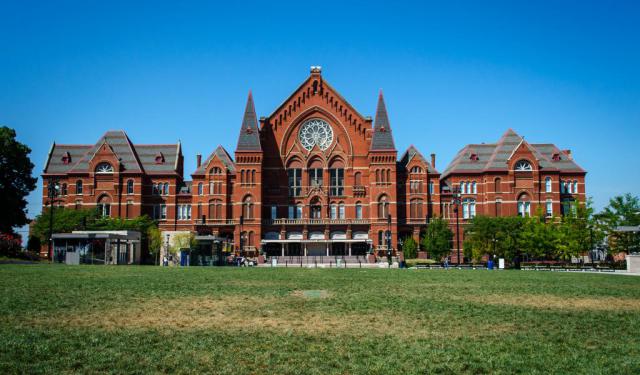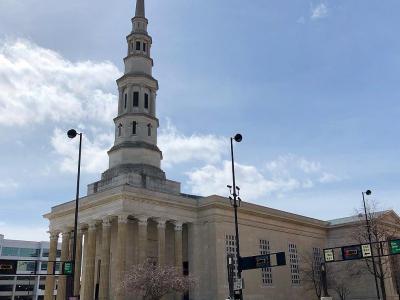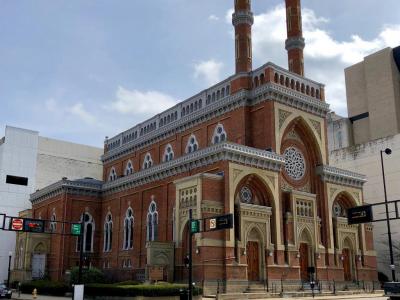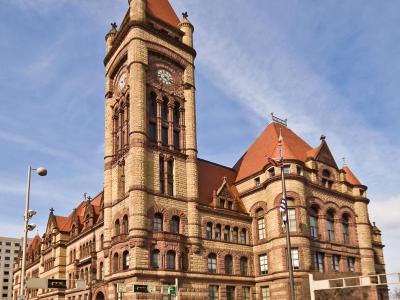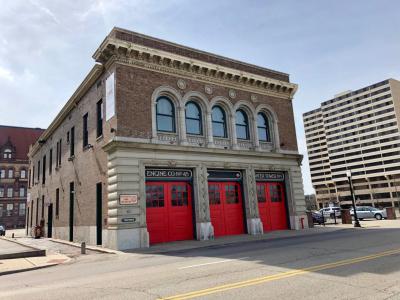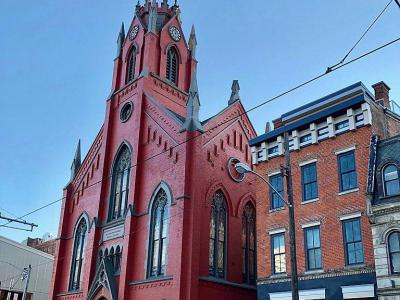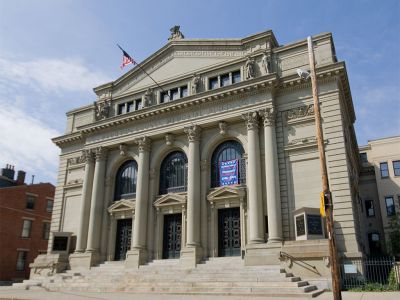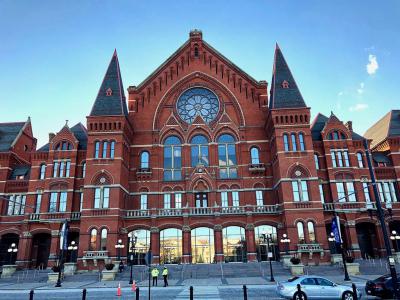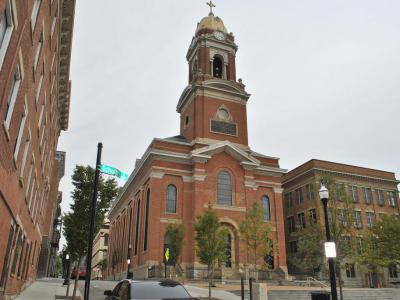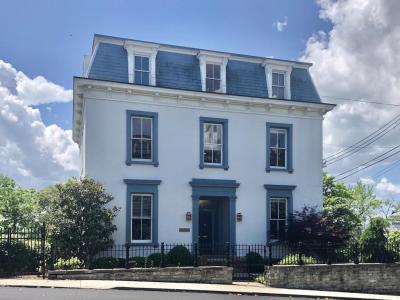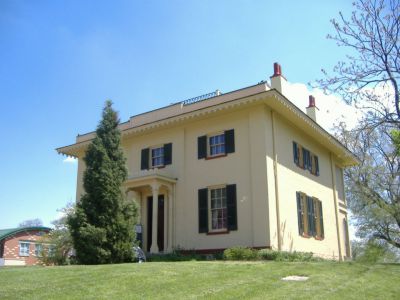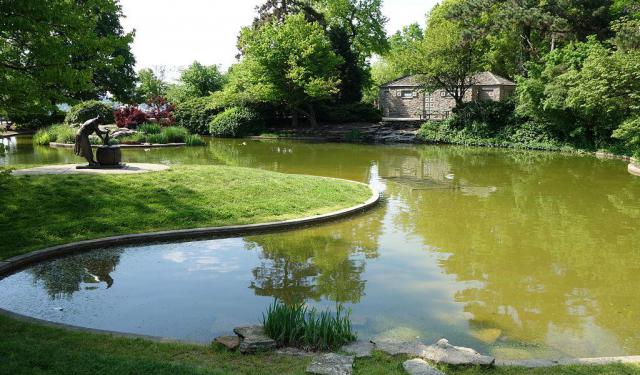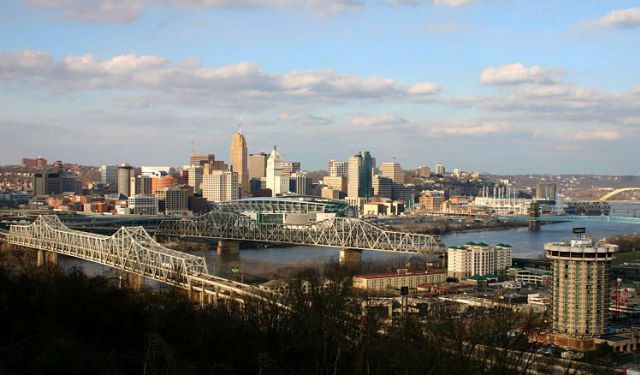Cincinnati's Historical Buildings (Self Guided), Cincinnati
A place where remarkable landmarks, river views and rolling hills are all part of the cityscape, Cincinnati, OH is a home to one of the most impressive collections of historic architecture in the United States. German homes, French cathedrals and splendid 19th-century mansions are found here in abundance. The list of architectural styles present in the city is truly impressive and includes Greek-, Renaissance- and Gothic Revival, Italianate, Richardsonian Romanesque, Art Deco and Moderne, to mention but a few.
Among the numerous structures noteworthy for their architectural characteristics or historic associations there are several distinctive gems. Suchlike is the St. Peter in Chains Cathedral – a Roman Catholic temple of Greek revival style, whose cornerstone was set on May 20, 1841; upon completion, it was the tallest structure in Cincinnati for its time.
Another prominent place of worship is the historic Isaac M. Wise Temple erected for Rabbi Isaac Mayer Wise, founder of American Reform Judaism.
Cincinnati City Hall – completed in 1893, this Richardsonian Romanesque structure was listed in the National Register of Historic Places on December 11, 1972. An optical trick, known as forced perspective, makes this building appear larger than it actually is.
Cincinnati Music Hall – built in 1878, this is one of the oldest and largest performance halls in the U.S., particularly noted for its Gothic German architecture.
William Howard Taft National Historic Site – is a two-story Greek Revival house built circa 1845 – the birthplace and childhood home of William Howard Taft, the 27th President of the United States.
If you're keen to marvel at these and other notable landmarks of Cincinnati, delve into the local history, and see how heritage informs fresh, fun, new experiences, take this self-guided walking tour!
Among the numerous structures noteworthy for their architectural characteristics or historic associations there are several distinctive gems. Suchlike is the St. Peter in Chains Cathedral – a Roman Catholic temple of Greek revival style, whose cornerstone was set on May 20, 1841; upon completion, it was the tallest structure in Cincinnati for its time.
Another prominent place of worship is the historic Isaac M. Wise Temple erected for Rabbi Isaac Mayer Wise, founder of American Reform Judaism.
Cincinnati City Hall – completed in 1893, this Richardsonian Romanesque structure was listed in the National Register of Historic Places on December 11, 1972. An optical trick, known as forced perspective, makes this building appear larger than it actually is.
Cincinnati Music Hall – built in 1878, this is one of the oldest and largest performance halls in the U.S., particularly noted for its Gothic German architecture.
William Howard Taft National Historic Site – is a two-story Greek Revival house built circa 1845 – the birthplace and childhood home of William Howard Taft, the 27th President of the United States.
If you're keen to marvel at these and other notable landmarks of Cincinnati, delve into the local history, and see how heritage informs fresh, fun, new experiences, take this self-guided walking tour!
How it works: Download the app "GPSmyCity: Walks in 1K+ Cities" from Apple App Store or Google Play Store to your mobile phone or tablet. The app turns your mobile device into a personal tour guide and its built-in GPS navigation functions guide you from one tour stop to next. The app works offline, so no data plan is needed when traveling abroad.
Cincinnati's Historical Buildings Map
Guide Name: Cincinnati's Historical Buildings
Guide Location: USA » Cincinnati (See other walking tours in Cincinnati)
Guide Type: Self-guided Walking Tour (Sightseeing)
# of Attractions: 10
Tour Duration: 2 Hour(s)
Travel Distance: 3.8 Km or 2.4 Miles
Author: Eveline
Sight(s) Featured in This Guide:
Guide Location: USA » Cincinnati (See other walking tours in Cincinnati)
Guide Type: Self-guided Walking Tour (Sightseeing)
# of Attractions: 10
Tour Duration: 2 Hour(s)
Travel Distance: 3.8 Km or 2.4 Miles
Author: Eveline
Sight(s) Featured in This Guide:
- St. Peter in Chains Cathedral
- Isaac M. Wise Temple
- Cincinnati City Hall
- Fire Museum of Greater Cincinnati
- Apostolic Bethlehem Temple Church
- Memorial Hall
- Music Hall
- St. Paul Church
- George Hunt Pendleton House
- William Howard Taft National Historic Site
1) St. Peter in Chains Cathedral
Located at the corner of 8th and Plum Streets in downtown Cincinnati, the Cathedral Basilica of Saint Peter in Chains is one of the city's most historic and architecturally striking landmarks. A cathedral of the Latin Church in the Archdiocese of Cincinnati, it is notable for its Greek Revival design and its dedication to Saint Peter’s imprisonment and liberation.
The cornerstone was laid on May 20, 1841, under the guidance of then-bishop John Baptist Purcell, who would later become archbishop. The church was officially dedicated on November 2, 1845, making it the first large Catholic church west of the Allegheny Mountains. In recognition of its historical and spiritual significance, Pope Francis designated it a minor basilica on June 29, 2020.
One of the basilica's most iconic features is its 224-foot white limestone spire, which towered over the Cincinnati skyline for decades as the tallest man-made structure in the city. The 33-foot-tall columns at the entrance are symbolically linked to the number of years in Jesus’ life.
Inside, the cathedral distinguishes itself with Greek-inspired mosaics representing the Stations of the Cross, Corinthian columns, and massive bronze doors. Artistic highlights include a crucifix attributed to Benvenuto Cellini, murals by Carl Zimmerman, and an apse mosaic by Anton Wendling. Originally, the cathedral also featured stone angels sculpted by Odoardo Fantacchiotti, among the first European sculptures brought to Cincinnati. These now reside at the Cincinnati Art Museum.
A major moment in the basilica's more recent history occurred in 1977 when Archbishop Karol Wojtyła of Poland-soon to become Pope John Paul II-visited the cathedral. Over the years, Saint Peter in Chains has hosted more than two dozen bishop consecrations, annual ordinations, and countless weddings, continuing its central role in Cincinnati’s Catholic life.
The cornerstone was laid on May 20, 1841, under the guidance of then-bishop John Baptist Purcell, who would later become archbishop. The church was officially dedicated on November 2, 1845, making it the first large Catholic church west of the Allegheny Mountains. In recognition of its historical and spiritual significance, Pope Francis designated it a minor basilica on June 29, 2020.
One of the basilica's most iconic features is its 224-foot white limestone spire, which towered over the Cincinnati skyline for decades as the tallest man-made structure in the city. The 33-foot-tall columns at the entrance are symbolically linked to the number of years in Jesus’ life.
Inside, the cathedral distinguishes itself with Greek-inspired mosaics representing the Stations of the Cross, Corinthian columns, and massive bronze doors. Artistic highlights include a crucifix attributed to Benvenuto Cellini, murals by Carl Zimmerman, and an apse mosaic by Anton Wendling. Originally, the cathedral also featured stone angels sculpted by Odoardo Fantacchiotti, among the first European sculptures brought to Cincinnati. These now reside at the Cincinnati Art Museum.
A major moment in the basilica's more recent history occurred in 1977 when Archbishop Karol Wojtyła of Poland-soon to become Pope John Paul II-visited the cathedral. Over the years, Saint Peter in Chains has hosted more than two dozen bishop consecrations, annual ordinations, and countless weddings, continuing its central role in Cincinnati’s Catholic life.
2) Isaac M. Wise Temple
The Isaac M. Wise Temple, formerly known as the Plum Street Temple, stands as a remarkable symbol of Jewish heritage and architectural elegance in Cincinnati. Constructed during the Civil War and dedicated on August 24, 1866, the temple is one of the oldest synagogue buildings still standing in the United States. It was erected for the congregation K.K. B’nai Yeshurun, founded by German Jewish immigrants who had split from K.K. Bene Israel in 1840.
This historic Reform Jewish congregation rose to national prominence under the leadership of Rabbi Isaac Mayer Wise, a pioneering figure in the development of Reform Judaism in America. With his dynamic vision and the congregation’s growing influence, Cincinnati became a key center of Jewish life in the U.S.
The temple was designed by noted Cincinnati architect James Keys Wilson, who drew inspiration from the Alhambra in Granada, Spain. The result is a stunning example of Moorish Revival architecture, richly ornamented and distinctively domed, located at 720 Plum Street-directly across from the Saint Peter In Chains Cathedral.
Originally founded in a home on Third Street and later in a Gothic Revival synagogue on Lodge Street, the congregation built Plum Street Temple to match its growing vision. In 1972, it made history as the site where Sally Priesand became the first woman rabbi ordained by a U.S. rabbinical seminary.
Honored for its architecture and history, Plum Street Temple became a National Historic Landmark in 1975. A year later, the congregation opened the Isaac M. Wise Center in Amberley Village, but the original temple still stands as a lasting symbol of faith and reform.
This historic Reform Jewish congregation rose to national prominence under the leadership of Rabbi Isaac Mayer Wise, a pioneering figure in the development of Reform Judaism in America. With his dynamic vision and the congregation’s growing influence, Cincinnati became a key center of Jewish life in the U.S.
The temple was designed by noted Cincinnati architect James Keys Wilson, who drew inspiration from the Alhambra in Granada, Spain. The result is a stunning example of Moorish Revival architecture, richly ornamented and distinctively domed, located at 720 Plum Street-directly across from the Saint Peter In Chains Cathedral.
Originally founded in a home on Third Street and later in a Gothic Revival synagogue on Lodge Street, the congregation built Plum Street Temple to match its growing vision. In 1972, it made history as the site where Sally Priesand became the first woman rabbi ordained by a U.S. rabbinical seminary.
Honored for its architecture and history, Plum Street Temple became a National Historic Landmark in 1975. A year later, the congregation opened the Isaac M. Wise Center in Amberley Village, but the original temple still stands as a lasting symbol of faith and reform.
3) Cincinnati City Hall
Cincinnati City Hall, completed in 1893, is the historic seat of the city's municipal government and a striking example of Richardsonian Romanesque architecture. Designed by prominent local architect Samuel Hannaford, the building showcases the architectural influence of H. H. Richardson, particularly notable after the demolition of Richardson's Cincinnati Chamber of Commerce building in 1911. Today, City Hall remains the best-preserved example of this architectural style in the city.
Located on the site of Cincinnati’s original city hall (built in 1852 and demolished in 1888), the current structure was added to the National Register of Historic Places on December 11, 1972. It rises four and a half stories and is topped by a commanding nine-story clock tower. The use of forced perspective-gradually decreasing the size of windows as the building ascends-creates the optical illusion that the structure is even taller than it truly is.
Constructed by the David Hummel Company of Cincinnati, the building incorporates materials from across the United States and beyond. Stones were sourced from Wisconsin, Ohio, Missouri, and Indiana; granite columns came from Vermont; marble staircases and wainscoting were brought in from Italy and Tennessee. Inside, stained glass windows illustrate scenes from Cincinnati's early history and depict the city's Roman namesake, Cincinnatus.
Today, Cincinnati City Hall stands not only as a functioning center of city government but also as a lasting monument to the city’s 19th-century architectural ambitions and Hannaford’s legacy in shaping the built environment of Cincinnati.
Located on the site of Cincinnati’s original city hall (built in 1852 and demolished in 1888), the current structure was added to the National Register of Historic Places on December 11, 1972. It rises four and a half stories and is topped by a commanding nine-story clock tower. The use of forced perspective-gradually decreasing the size of windows as the building ascends-creates the optical illusion that the structure is even taller than it truly is.
Constructed by the David Hummel Company of Cincinnati, the building incorporates materials from across the United States and beyond. Stones were sourced from Wisconsin, Ohio, Missouri, and Indiana; granite columns came from Vermont; marble staircases and wainscoting were brought in from Italy and Tennessee. Inside, stained glass windows illustrate scenes from Cincinnati's early history and depict the city's Roman namesake, Cincinnatus.
Today, Cincinnati City Hall stands not only as a functioning center of city government but also as a lasting monument to the city’s 19th-century architectural ambitions and Hannaford’s legacy in shaping the built environment of Cincinnati.
4) Fire Museum of Greater Cincinnati
Housed in the beautifully restored 1906 Court Street Firehouse, the Fire Museum of Greater Cincinnati invites visitors into the proud legacy of American firefighting-right in the city where it all began. Cincinnati holds the distinction of establishing the first paid professional fire department in the United States back in 1853, and this museum is both a tribute to that groundbreaking moment and an educational hub that continues to serve the community.
Listed on the National Register of Historic Places since 1974, the museum showcases over 200 years of firefighting history through one of the nation’s most impressive collections of artifacts. Highlights include early leather fire buckets, an 1808 fire drum, an 1836 hand pumper, and Cincinnati’s oldest surviving fire engine. For younger visitors-or just the young at heart-there’s also an interactive Emergency-One fire engine cab, complete with working sirens, bells, and flashing lights.
But this museum offers more than just a look into the past. With the support of the Cincinnati Fire Department, it also operates a top-tier fire safety education program. Guests can take part in a hands-on, simulated fire experience set in a mock home, learning how to prevent fires and safely respond if one occurs. The 60-minute guided tours, available by reservation, are suitable for all ages.
Since its transformation from Engine Company #45 Firehouse into a museum in 1980, the Fire Museum of Greater Cincinnati has honored the city’s legacy while helping to save lives through education. It’s a must-see destination for history buffs, families, and anyone interested in the evolution of fire service in America.
Listed on the National Register of Historic Places since 1974, the museum showcases over 200 years of firefighting history through one of the nation’s most impressive collections of artifacts. Highlights include early leather fire buckets, an 1808 fire drum, an 1836 hand pumper, and Cincinnati’s oldest surviving fire engine. For younger visitors-or just the young at heart-there’s also an interactive Emergency-One fire engine cab, complete with working sirens, bells, and flashing lights.
But this museum offers more than just a look into the past. With the support of the Cincinnati Fire Department, it also operates a top-tier fire safety education program. Guests can take part in a hands-on, simulated fire experience set in a mock home, learning how to prevent fires and safely respond if one occurs. The 60-minute guided tours, available by reservation, are suitable for all ages.
Since its transformation from Engine Company #45 Firehouse into a museum in 1980, the Fire Museum of Greater Cincinnati has honored the city’s legacy while helping to save lives through education. It’s a must-see destination for history buffs, families, and anyone interested in the evolution of fire service in America.
5) Apostolic Bethlehem Temple Church
Standing tall at 1205 Elm Street on the edge of Cincinnati’s historic Over-the-Rhine neighborhood, the Apostolic Bethlehem Temple Church is a landmark of both faith and architecture. Originally constructed in 1868, this German Gothic Revival church was built for the German Evangelical and Reformed Church, the city’s oldest congregation of its kind, founded back in 1814.
The building features hallmark Gothic elements: a rectangular, two-story structure with a central tower rising from the east-facing façade, flanked by transepts on either side-an architectural nod to traditional German churches. Entry is through the prominent tower, which immediately evokes a sense of historical gravity and reverence.
Over the decades, the building’s story evolved. In 1874, the church was renamed Saint John’s German Protestant Church while still part of the German Reformed Church. A significant shift occurred in 1924 when the congregation joined the American Unitarian Association and became Saint John's Unitarian Church. However, by the mid-20th century, the congregation moved elsewhere, and the building sat unused until it found new life with its current occupants-a Pentecostal congregation.
Today, the Apostolic Bethlehem Temple Church not only serves as a house of worship but also as a piece of Cincinnati’s living history. In 1973, it was officially listed on the National Register of Historic Places, recognized for its architectural distinction and cultural significance. By 1983, it became one of the many contributing properties within the broader Over-the-Rhine Historic District.
Just steps away from Cincinnati Music Hall and a neighborhood park, this church continues to stand as a symbol of the city's evolving spiritual and cultural tapestry.
The building features hallmark Gothic elements: a rectangular, two-story structure with a central tower rising from the east-facing façade, flanked by transepts on either side-an architectural nod to traditional German churches. Entry is through the prominent tower, which immediately evokes a sense of historical gravity and reverence.
Over the decades, the building’s story evolved. In 1874, the church was renamed Saint John’s German Protestant Church while still part of the German Reformed Church. A significant shift occurred in 1924 when the congregation joined the American Unitarian Association and became Saint John's Unitarian Church. However, by the mid-20th century, the congregation moved elsewhere, and the building sat unused until it found new life with its current occupants-a Pentecostal congregation.
Today, the Apostolic Bethlehem Temple Church not only serves as a house of worship but also as a piece of Cincinnati’s living history. In 1973, it was officially listed on the National Register of Historic Places, recognized for its architectural distinction and cultural significance. By 1983, it became one of the many contributing properties within the broader Over-the-Rhine Historic District.
Just steps away from Cincinnati Music Hall and a neighborhood park, this church continues to stand as a symbol of the city's evolving spiritual and cultural tapestry.
6) Memorial Hall
The Hamilton County Memorial Building, known by most as Memorial Hall, is a building created as a memorial to members of the military from Cincinnati and Hamilton County.
The building was funded by a cooperation between the Grand Army of the Republic and Hamilton County. In 1908, the two entities enlisted Samuel Hannaford & Sons to design the Beaux Arts-style memorial hall.
The hall hosts a 556-seat theatre that is used for concerts, events and ceremonies. Tourists can purchase tickets to see one of the many shows so they can get a glimpse of the hall's interior. With over 300 shows hosted each year, it is very easy to find a performance. Likewise, Memorial Hall attempts to offer as many low-cost or free performances as possible.
Many visitors forego the performances and simply enjoy viewing the columns and sculpted figures that adorn the exterior of the building. The location of Memorial Hall makes it an easy stop on a walking tour. It is in the Over-the-Rhine neighborhood, adjacent to Washington Park and south of Music Hall.
The building was funded by a cooperation between the Grand Army of the Republic and Hamilton County. In 1908, the two entities enlisted Samuel Hannaford & Sons to design the Beaux Arts-style memorial hall.
The hall hosts a 556-seat theatre that is used for concerts, events and ceremonies. Tourists can purchase tickets to see one of the many shows so they can get a glimpse of the hall's interior. With over 300 shows hosted each year, it is very easy to find a performance. Likewise, Memorial Hall attempts to offer as many low-cost or free performances as possible.
Many visitors forego the performances and simply enjoy viewing the columns and sculpted figures that adorn the exterior of the building. The location of Memorial Hall makes it an easy stop on a walking tour. It is in the Over-the-Rhine neighborhood, adjacent to Washington Park and south of Music Hall.
7) Music Hall
Music Hall is Cincinnati's performance hall for classical arts. Music Hall is the venue for the Cincinnati Ballet, Symphony Orchestra, Opera and Pops Orchestra.
The building was completed in 1878. It was designed by Samuel Hannaford in the Victorian Gothic Revival Architectural Style. It is distinctive from other performance halls in that the building is actually three separate buildings: Music Hall and the North and South Exposition Buildings.
The buildings feature sandstone carvings, a pitched gable roof and a large rose window. Music Hall originally had intricately carved brickwork, but most of the details were destroyed during a renovation of the building.
Those who enjoy sites that are reputed to be haunted should pay particular interest to Music Hall. It is said to be one of the most haunted places in America due to the fact that it was built over a pauper's cemetery.
Music Hall was named a National Historic Landmark in 1975. It has also been placed on the list of America's 11 most endangered historic places.
The building was completed in 1878. It was designed by Samuel Hannaford in the Victorian Gothic Revival Architectural Style. It is distinctive from other performance halls in that the building is actually three separate buildings: Music Hall and the North and South Exposition Buildings.
The buildings feature sandstone carvings, a pitched gable roof and a large rose window. Music Hall originally had intricately carved brickwork, but most of the details were destroyed during a renovation of the building.
Those who enjoy sites that are reputed to be haunted should pay particular interest to Music Hall. It is said to be one of the most haunted places in America due to the fact that it was built over a pauper's cemetery.
Music Hall was named a National Historic Landmark in 1975. It has also been placed on the list of America's 11 most endangered historic places.
8) St. Paul Church
Located at the corner of Twelfth and Spring Streets in Cincinnati’s Pendleton neighborhood, Saint Paul Church is a striking remnant of the city’s German-Catholic heritage and an example of adaptive reuse done right. Established in 1848 by German-speaking parishioners from nearby Saint Mary’s Church, the church was born out of the growing need for a place of worship east of Clay Street. By 1850, the church stood tall, a 150-by-68-foot brick structure crowned with a tin-covered gabled roof.
Tragedy struck in 1899 when a fire destroyed much of the church. Miraculously, the original German-made stained glass windows and walls survived. Reconstruction was immediate, and a reborn Saint Paul’s reopened in 1900, featuring a luminous interior framed by twelve Corinthian columns and adorned with a Renaissance tower topped by a Pope’s Mitre cupola and gilded cross. Romanesque in style, the building also sports Doric pilasters and grand arched windows, with three elegant arched doorways facing Spring Street.
After being deconsecrated in 1974, the church was added to the National Register of Historic Places, and recognized as the centerpiece of the Saint Paul Church Historic District. In 1981, The Verdin Company-a Cincinnati-based bell and clock manufacturer-purchased and restored the entire complex, transforming the church into a bell and clock museum and converting other buildings into art galleries. Their efforts earned them an award from the Ohio Historical Society in 1983 for outstanding preservation and reuse.
Today, under the care of Cafeo Hospitality, Saint Paul Church has entered yet another chapter of its story: it now serves as an atmospheric venue for weddings and corporate events, where echoes of its past mingle with modern celebration. Parish records are preserved at Old Saint Mary’s Church.
Tragedy struck in 1899 when a fire destroyed much of the church. Miraculously, the original German-made stained glass windows and walls survived. Reconstruction was immediate, and a reborn Saint Paul’s reopened in 1900, featuring a luminous interior framed by twelve Corinthian columns and adorned with a Renaissance tower topped by a Pope’s Mitre cupola and gilded cross. Romanesque in style, the building also sports Doric pilasters and grand arched windows, with three elegant arched doorways facing Spring Street.
After being deconsecrated in 1974, the church was added to the National Register of Historic Places, and recognized as the centerpiece of the Saint Paul Church Historic District. In 1981, The Verdin Company-a Cincinnati-based bell and clock manufacturer-purchased and restored the entire complex, transforming the church into a bell and clock museum and converting other buildings into art galleries. Their efforts earned them an award from the Ohio Historical Society in 1983 for outstanding preservation and reuse.
Today, under the care of Cafeo Hospitality, Saint Paul Church has entered yet another chapter of its story: it now serves as an atmospheric venue for weddings and corporate events, where echoes of its past mingle with modern celebration. Parish records are preserved at Old Saint Mary’s Church.
9) George Hunt Pendleton House
Perched high on Liberty Hill in Cincinnati’s Prospect Hill Historic District, the George H. Pendleton House stands as a striking example of French Second Empire architecture and a quiet witness to a major shift in American political history. Built in 1870, this 2½-story brick mansion-with its iconic mansard roof, bracketed eaves, and dormered third floor-served as the home of Senator George Hunt Pendleton from 1879 to 1889.
Pendleton, a Democratic politician and lawyer, is best known for the Pendleton Act of 1883, the landmark legislation that began the transformation of federal hiring from patronage to merit-based civil service. Ironically, though he wasn’t initially a vocal reformer, Pendleton hosted a pivotal 1882 meeting in this very house, where a Senate subcommittee completed a draft of the bill that would bear his name. That reform effort won national praise-but cost him his Senate seat in 1884, alienating party insiders who had thrived under the old patronage system.
Over the years, the house transitioned through various owners and uses, at one point becoming a nine-unit tenement. While the interior has been heavily modified and lost its historical integrity, the exterior was restored in the late 20th century, preserving its prominent silhouette visible from the downtown Cincinnati basin below. Today, the structure hosts commercial offices on the ground floor and residences above, blending history with modern utility.
In 1964, the George H. Pendleton House was designated a National Historic Landmark, a nod to both its architectural presence and its role in reshaping the U.S. government.
Pendleton, a Democratic politician and lawyer, is best known for the Pendleton Act of 1883, the landmark legislation that began the transformation of federal hiring from patronage to merit-based civil service. Ironically, though he wasn’t initially a vocal reformer, Pendleton hosted a pivotal 1882 meeting in this very house, where a Senate subcommittee completed a draft of the bill that would bear his name. That reform effort won national praise-but cost him his Senate seat in 1884, alienating party insiders who had thrived under the old patronage system.
Over the years, the house transitioned through various owners and uses, at one point becoming a nine-unit tenement. While the interior has been heavily modified and lost its historical integrity, the exterior was restored in the late 20th century, preserving its prominent silhouette visible from the downtown Cincinnati basin below. Today, the structure hosts commercial offices on the ground floor and residences above, blending history with modern utility.
In 1964, the George H. Pendleton House was designated a National Historic Landmark, a nod to both its architectural presence and its role in reshaping the U.S. government.
10) William Howard Taft National Historic Site
Located on Auburn Avenue in Cincinnati’s Mount Auburn Historic District, the William Howard Taft National Historic Site preserves the birthplace and childhood home of the only person to serve as both President and Chief Justice of the United States-William Howard Taft. Just a mile north of downtown, the home sits in what was once a summer escape for Cincinnati’s upper class, drawn to Mount Auburn’s breezy hills.
The house, a modest Greek Revival structure likely built in the early 1840s by the Bowen family, became home to the Taft family in the early 1850s. Alphonso Taft, a Vermont transplant and prominent Cincinnati lawyer, moved in with his wife Fanny Phelps Taft, who sadly died just a year later. Alphonso remarried in 1853, and his second wife, Louise Torrey, gave birth to William Howard Taft in the home’s rear nursery on September 15, 1857.
Though smaller than neighboring mansions, the Taft home was still a hub of activity. It hosted local politicians and future president James A. Garfield, with rugs rolled up in the parlor for dancing. Alphonso’s library, filled with his book collection, served as the family’s intellectual center.
William lived there until leaving for Yale in 1874. The family's connection to the house gradually diminished, especially after a fire damaged the upper floor in 1877. Alphonso and Louise leased out the home in 1889 and relocated to California. After Alphonso died in 1891, the house served as a temporary gathering place for mourners.
In 1964, the site was officially designated a National Historic Landmark, recognizing both the architectural and historical significance of the house where a future president once played, read, and dreamed.
The house, a modest Greek Revival structure likely built in the early 1840s by the Bowen family, became home to the Taft family in the early 1850s. Alphonso Taft, a Vermont transplant and prominent Cincinnati lawyer, moved in with his wife Fanny Phelps Taft, who sadly died just a year later. Alphonso remarried in 1853, and his second wife, Louise Torrey, gave birth to William Howard Taft in the home’s rear nursery on September 15, 1857.
Though smaller than neighboring mansions, the Taft home was still a hub of activity. It hosted local politicians and future president James A. Garfield, with rugs rolled up in the parlor for dancing. Alphonso’s library, filled with his book collection, served as the family’s intellectual center.
William lived there until leaving for Yale in 1874. The family's connection to the house gradually diminished, especially after a fire damaged the upper floor in 1877. Alphonso and Louise leased out the home in 1889 and relocated to California. After Alphonso died in 1891, the house served as a temporary gathering place for mourners.
In 1964, the site was officially designated a National Historic Landmark, recognizing both the architectural and historical significance of the house where a future president once played, read, and dreamed.
Walking Tours in Cincinnati, Ohio
Create Your Own Walk in Cincinnati
Creating your own self-guided walk in Cincinnati is easy and fun. Choose the city attractions that you want to see and a walk route map will be created just for you. You can even set your hotel as the start point of the walk.
Over-the-Rhine District Walking Tour
The historic Over-The-Rhine (OTR) neighborhood is one of the largest districts in the U.S. recognized by the National Register of Historic Places. Its name comes from the predominantly German immigrants who developed the area in the mid-19th century and had to commute across bridges over the Miami and Erie Canal (nicknamed "the Rhine" in reference to the river in Germany) which separated... view more
Tour Duration: 1 Hour(s)
Travel Distance: 2.0 Km or 1.2 Miles
Tour Duration: 1 Hour(s)
Travel Distance: 2.0 Km or 1.2 Miles
Eden Park Walking Tour
Eden Park is undoubtedly the most popular park in Cincinnati, Ohio. This large outdoor area blends culture, history, and architecture in one stunning location. The park spans across lush greenery and scenic spots, making it a beloved retreat for locals and tourists alike. Apart from offering a tranquil escape amidst the urban bustle, Eden Park is also home to a number of famous city landmarks.
... view more
Tour Duration: 2 Hour(s)
Travel Distance: 2.5 Km or 1.6 Miles
... view more
Tour Duration: 2 Hour(s)
Travel Distance: 2.5 Km or 1.6 Miles
Cincinnati Introduction Walking Tour
Welcome to Cincinnati, Ohio-a place that blends historical richness with the vibrancy of cultural attractions!
The land that became Cincinnati had previously been occupied by Fort Washington. Before that, it was home to the Shawnee and other Native American tribes like the Miami, Ojibwe, and Lenape.
Founded in 1788, the city earned its name from the Society of the Cincinnati, the... view more
Tour Duration: 2 Hour(s)
Travel Distance: 3.0 Km or 1.9 Miles
The land that became Cincinnati had previously been occupied by Fort Washington. Before that, it was home to the Shawnee and other Native American tribes like the Miami, Ojibwe, and Lenape.
Founded in 1788, the city earned its name from the Society of the Cincinnati, the... view more
Tour Duration: 2 Hour(s)
Travel Distance: 3.0 Km or 1.9 Miles
The Most Popular Cities
/ view all
